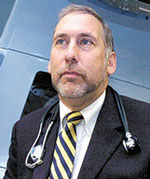–

LOUISVILLE, Ky. (FinalCall.com) – As shocking as it sounds, poverty and racism are actually direct causes of cancer, this according to Dr. Edward Halperin, a clinical oncologist, historian, and dean of the Medical School at the University of Louisville.
“The big issues are not changing the window of insurance (in the new health reform legislation approved by Congress),” Dr. Halperin told members of the Trotter Group of African American Columnists and Commentators meeting here April 20.
The really big issues are: “The small number of African American medical students; the small number of African American medical students who end up caring for patients in underserved areas; the particular problem of African American male medical students; the issue of ‘food deserts’ in urban areas and their contribution to incidences of obesity, diabetes, hypertension and cancer; and the differential outcome of African American patients once they enter the system.”
These six major problems, according to Dr. Halperin, affect whether or not people get into the medical treatment system in the first place, whether or not they havemore advanced diseases, and whether their treatment outcomes are any different once they enter the treatment system.
“Twenty-seven percent of U.S. physicians provide 80 percent of the health care for African Americans in the United States,” Dr. Halperin said. “You have a large number of highly overworked physicians trying to take care of a large inventory of patients, and things like this extension of the insurance are not getting at the big problem,” he said, citing an article published in 2004 in the New England Journal of Medicine.
If you look at cancer occurring in the lung, colon, cervix, breast, or prostate, they are all more common among Blacks, and they are not treated until the diseases are more advanced in Black patients than in Whites, and the survival rates are lower, he continued.
“African Americans are less likely to get curative lobectomy for Stage One and early Stage Two lung cancer than Whites. They less often get screening colonoscopy, mammography, pap smears. They enter the health care system at a later date than Caucasians, and their survival rates are different.
“Poverty is a carcinogen. The incidence of cancer is closely related to poverty, as is obesity, as is hypertension,” Dr. Halperin declared. “You could make a map of the city of Louisville, or the city of Chicago and plot cancer rates, obesity rates, hypertension rates, and stroke rates, as a function of median income, per zip code and they correlate very well.
“You can map cancer rates, obesity rates as a function of ‘food deserts’ and they correlate very well. That’s the data,” said Dr. Halperin.
“The classic study by the epidemiologists (Lewis) Dahl and Ketoe show that in the United States, you can explain about one third of adult cancer, based on smoking; one third of adult cancer based on diet; and the remaining one third of adult cancer is explicable based on alcohol, environmental carcinogens and genetics.
“Where are the smoking rates highest in the United States? They are inversely correlated with income and with years of education. So they’re highest in poor areas,” Dr. Halperin told the Trotter Group members in response to a challenge from The Final Call to prove that poverty is a cause of cancer.
“Where (are) obesity rates and the lack of access to fresh fruits and vegetables highest? They’re in food deserts in poor areas. Where (are) alcohol rates higher? They’re highest in poor areas. What places have the lowest incidents of mammography, pap smears, PSA-testing for prostate cancer, colorectal routine cancer screening? They are in poor neighborhoods. There is an enormous amount of data in the Peer Review literature, showing these correlations,” Dr. Halperin said.
“The study of ‘food deserts’ is a term used to refer to decreased access to fresh fruits and vegetables. There are many places in the United States where it’s much easier to buy a pint of whisky, a lottery ticket and a bag of Fritos, than it is to get a tomato or an apple. This has been well studied. This is called ‘food deserts.’ The term was coined in poor areas, in England and in Ireland.
“You can map out cities where you can’t find a Kroger Supermarket. They all want to be in the high demographic areas, so what you can buy are Fritos, Coca-Cola, lottery tickets and liquor, and those food deserts also have the highest incidents of cancer, obesity, hypertension. That’s the data,” he said.
The excuses offered by the convenience stores which do not stock healthy foods in poor neighborhoods are invalid, Dr. Halperin insists.
“You can get a cold beer anyplace in the United States. So how come you can’t get fresh fruits and vegetables? They tell us you can’t deliver AIDS drugs to Africa. Anyone who’s ever traveled, you can get a Heineken or a Budweiser anyplace on the planet Earth, and it’s cold. But somehow we can’t deliver drugs. So, that’s the capitalist system,” he said.
Of the overworked minority of physicians treating Black patients–27 percent of all doctors, providing the care for 80 percent of all Black patients–those doctors are further hampered because they have less training; less access to clinical resources; and less access to clinical trials, factors which all add up in the end.
The outcome resulting from this combination of factors? Poor Americans have a 10 percent to 15 percent lower five-year cancer survival rate than the middle class or wealthy persons, according to Dr. Halperin’s notes.
Described in another way: “Patients with a lower socioeconomic status have a 35 percent increase in (cancer) mortality,” Dr. T. Byers of the University of Colorado School of Public Health said June 26, 2008, according to Dr. Halperin.
Related news:
The nexus between health and wealth (FCN, 12-22-2008)
Dying for care: Video captures emergency room death (FCN, 07-15-2008)












